


The landscape of clinical trials is undergoing a significant transformation, driven by an urgent demand for patient diversity. With fewer than 4% of adults in the U.S. participating in research studies, and a stark underrepresentation of minorities, the challenge of inclusivity in clinical trials is more pressing than ever. This article explores ten innovative strategies aimed at enhancing patient diversity recruitment, providing insights into how organizations can effectively engage underrepresented populations and improve research outcomes.
How can these strategies not only bridge the gap in diversity but also redefine the very fabric of clinical research?
bioaccess® stands out in accelerating patient diversity recruitment strategies by strategically leveraging its operational bases in Latin America, the Balkans, and Australia. By skillfully navigating local regulatory frameworks and engaging diverse patient groups, bioaccess® employs patient diversity recruitment strategies to foster quicker and more inclusive studies. This approach not only enhances the representation of various demographics but also significantly elevates the quality and relevance of research outcomes.
Consider this: less than 4% of adults in the U.S. participate in research studies, and historically, minorities have been underrepresented-only 17% of U.S. Parkinson’s research studies reported racial and ethnic demographics. In this context, bioaccess®'s commitment to diversity is not just important; it's essential. The organization utilizes patient diversity recruitment strategies, such as community outreach and culturally appropriate engagement, to ensure that studies reflect the populations they aim to serve. This ultimately leads to more reliable and applicable outcomes.
Moreover, bioaccess® has activated over 50 sites in under eight weeks, showcasing its efficiency in patient recruitment and site activation services. In collaboration with Caribbean Health Group, bioaccess® is also working to position Barranquilla as a key hub for research studies in Latin America, with support from Colombia's Minister of Health. This partnership enhances its capacity to attract diverse patient groups and streamline research processes, backed by FDA/EMA/MDR-ready datasets with centralized monitoring.

Collaborating with expert groups focused on patient diversity recruitment strategies significantly enhances efforts to recruit participants for clinical trials. These organizations have established networks and deep trust within their communities, making them invaluable allies in reaching underrepresented groups. For example, initiatives like the ONE in a MILLION framework have successfully engaged 279 communities, showcasing the effectiveness of targeted outreach in improving recruitment efforts. By partnering on outreach initiatives, trial sponsors can utilize patient diversity recruitment strategies to tap into these networks, ensuring a more diverse participant pool that is essential for the validity of trial results.
Moreover, sites that received cultural safety training from COUCH Health reported a 26% increase in the enrollment of diverse patients, emphasizing the importance of patient diversity recruitment strategies in fostering inclusivity. Engaging with these organizations not only enhances hiring processes but also contributes to creating a more equitable healthcare environment, ultimately benefiting the entire research ecosystem. Alarmingly, only 3%-5% of adult cancer patients participate in clinical trials in the U.S., highlighting the urgent need to improve diversity in enrollment efforts.
Additionally, COUCH Health's initiatives have shown a 21% improvement in screen failure rates, further illustrating the positive outcomes of collaboration with professional organizations. This data emphasizes the critical role of partnerships in addressing the challenges of clinical research and implementing patient diversity recruitment strategies.
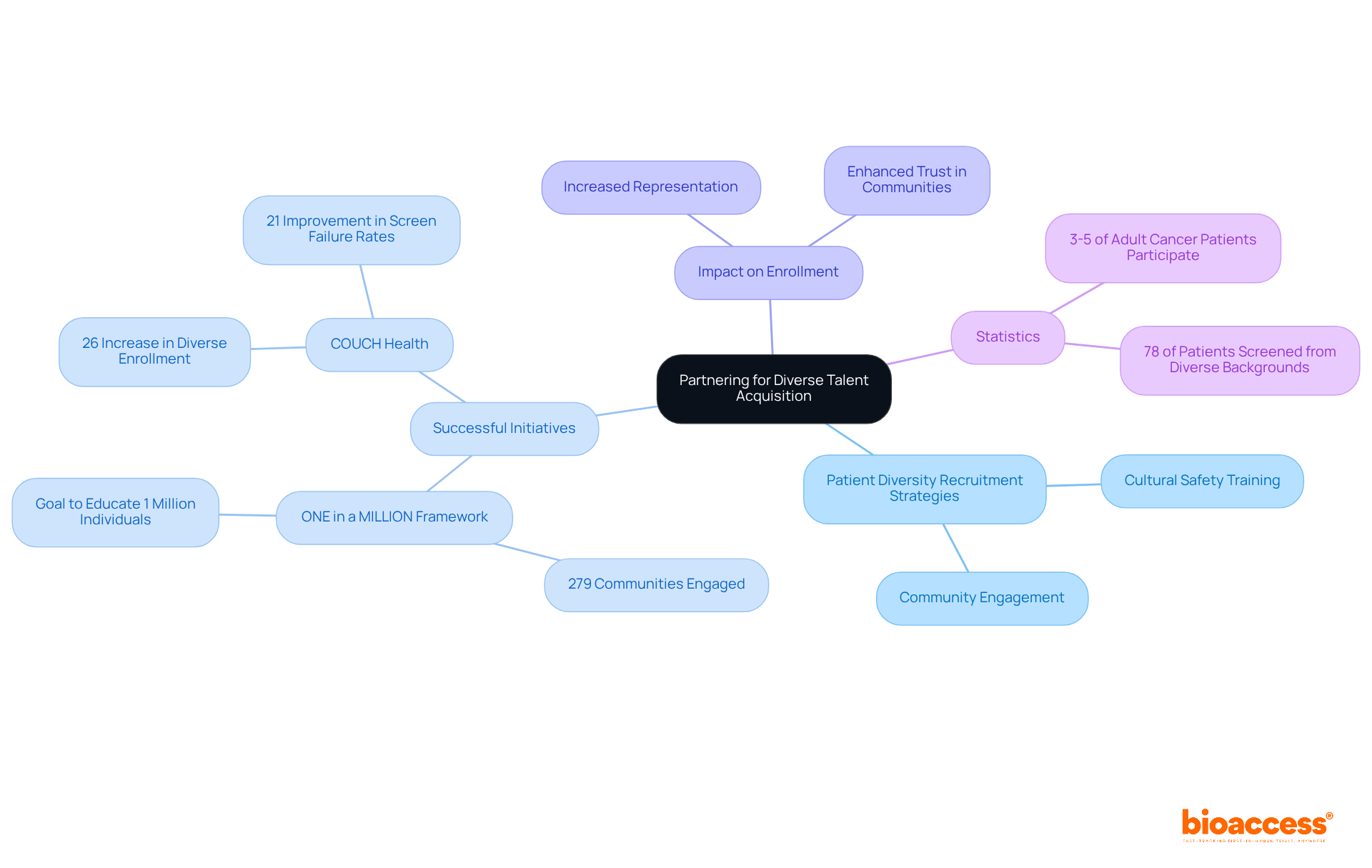
Training hiring management to identify and address unconscious bias is crucial for fostering an inclusive hiring atmosphere in clinical research. By conducting workshops and training sessions, staff can gain insights into their biases and learn effective strategies to counteract them. Implementing standardized interview processes and diverse hiring panels not only promotes fairness but also enhances the overall quality of candidate assessment. This proactive approach ensures that all candidates are evaluated equitably, ultimately improving diversity in clinical trial selection.
Consider the impact of unconscious bias on your hiring practices. Are you confident that your current processes are equitable? By prioritizing training and awareness, organizations can enhance their patient diversity recruitment strategies to create a more inclusive environment that attracts a diverse range of talent. This commitment to patient diversity recruitment strategies is not just a moral imperative; it is essential for advancing innovation and improving outcomes in clinical research.
In summary, addressing unconscious bias through targeted training is a vital step toward achieving a more inclusive hiring process. By collaborating and implementing patient diversity recruitment strategies, organizations can ensure that they are not only compliant but also leaders in advancing diversity within the clinical trial landscape.
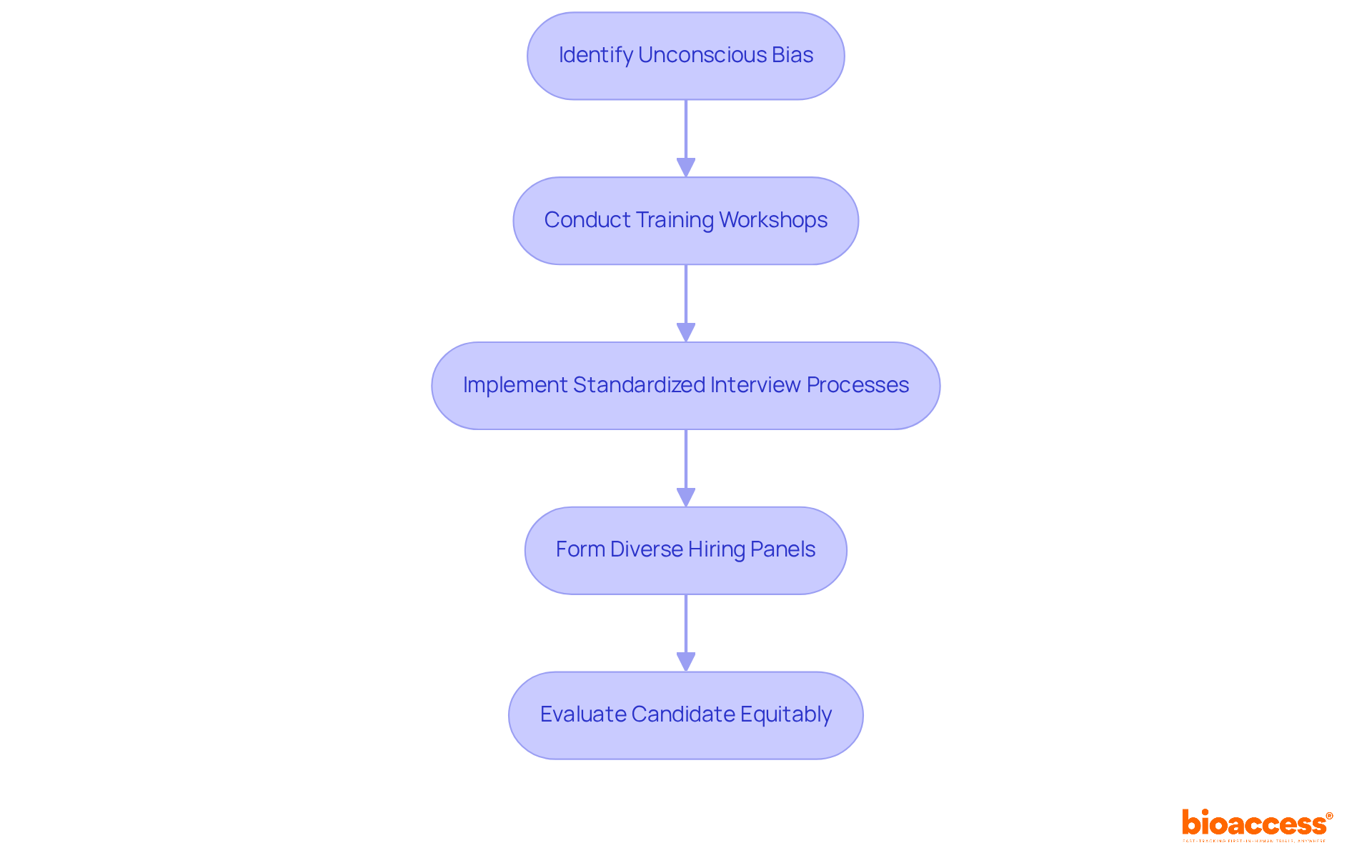
Establishing a Diversity and Inclusion Committee is essential for providing strategic oversight of patient diversity recruitment strategies within clinical research. This committee should include members from diverse backgrounds, ensuring that a variety of perspectives are integrated into decision-making processes. By setting clear goals and regularly assessing progress, the committee can enhance accountability and cultivate a culture of inclusivity within the organization.
Research institutions have demonstrated the benefits of committees that implement patient diversity recruitment strategies, as they not only promote effective participant strategies but also align with current trends that underscore the importance of diversity in research studies. As Sundar Pichai aptly noted, a diverse mix of voices leads to better discussions, decisions, and outcomes. This makes the establishment of these committees a critical step toward achieving health equity.
In the evolving Medtech landscape, the role of bioaccess in addressing key challenges cannot be overstated. By fostering collaboration and leveraging diverse insights, organizations can navigate complexities more effectively. The next steps involve actively engaging with these committees to ensure that patient diversity recruitment strategies remain at the forefront of clinical research initiatives.
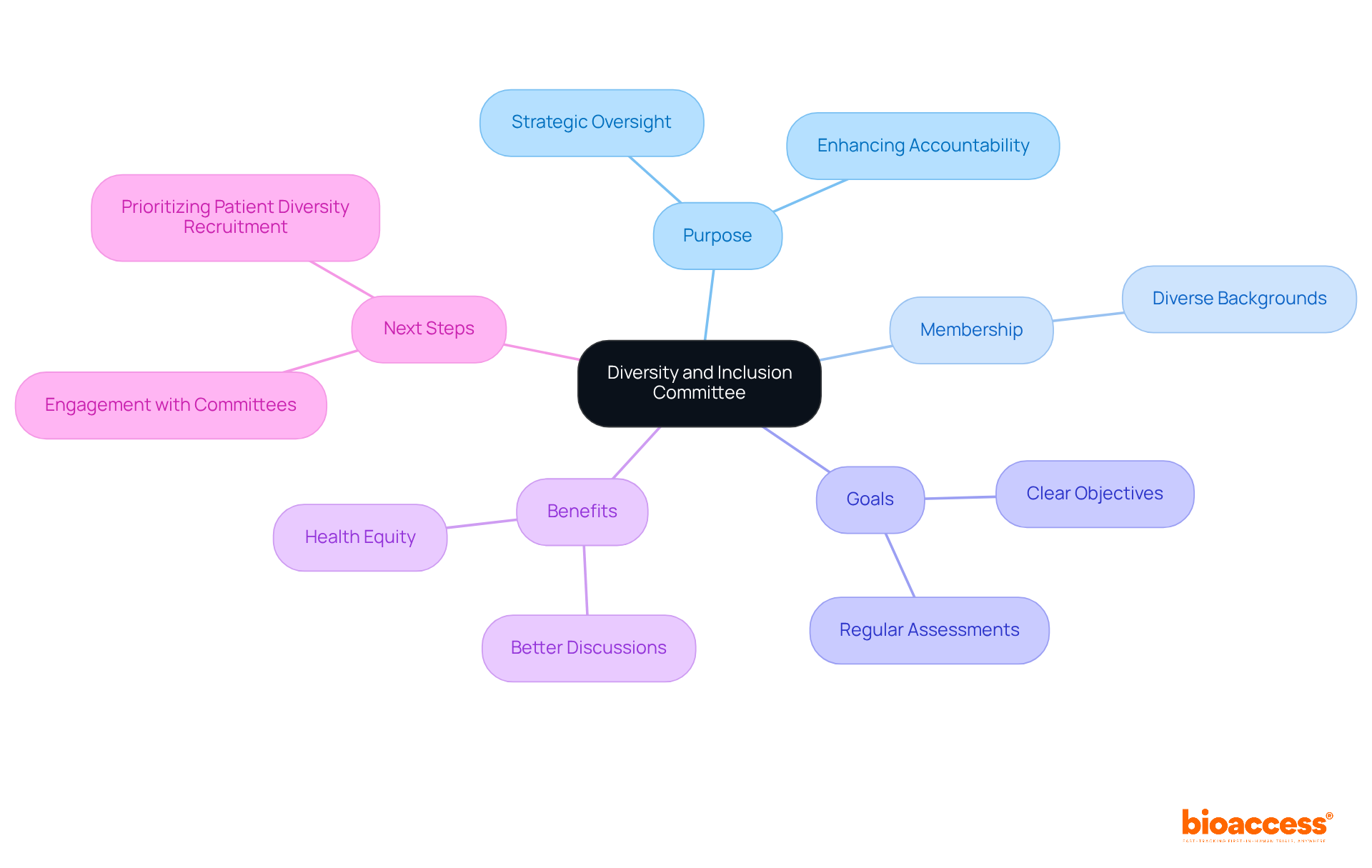
Establishing patient diversity recruitment strategies is crucial for enhancing the candidate pool in medical studies, particularly for Medtech, Biopharma, and Radiopharma startups that often struggle with patient recruitment. These programs must include:
Given the persistent challenges these startups face in securing participation from healthcare providers, coupled with their financial constraints, implementing patient diversity recruitment strategies becomes essential.
By ensuring that medical studies accurately reflect the demographics of the populations they aim to assist, organizations can significantly boost participation rates. This approach not only fosters inclusivity but also contributes to achieving fairer health outcomes.
Collaboration among stakeholders is vital in this endeavor, as it lays the groundwork for more effective patient diversity recruitment strategies and ultimately enhances the quality of clinical research.
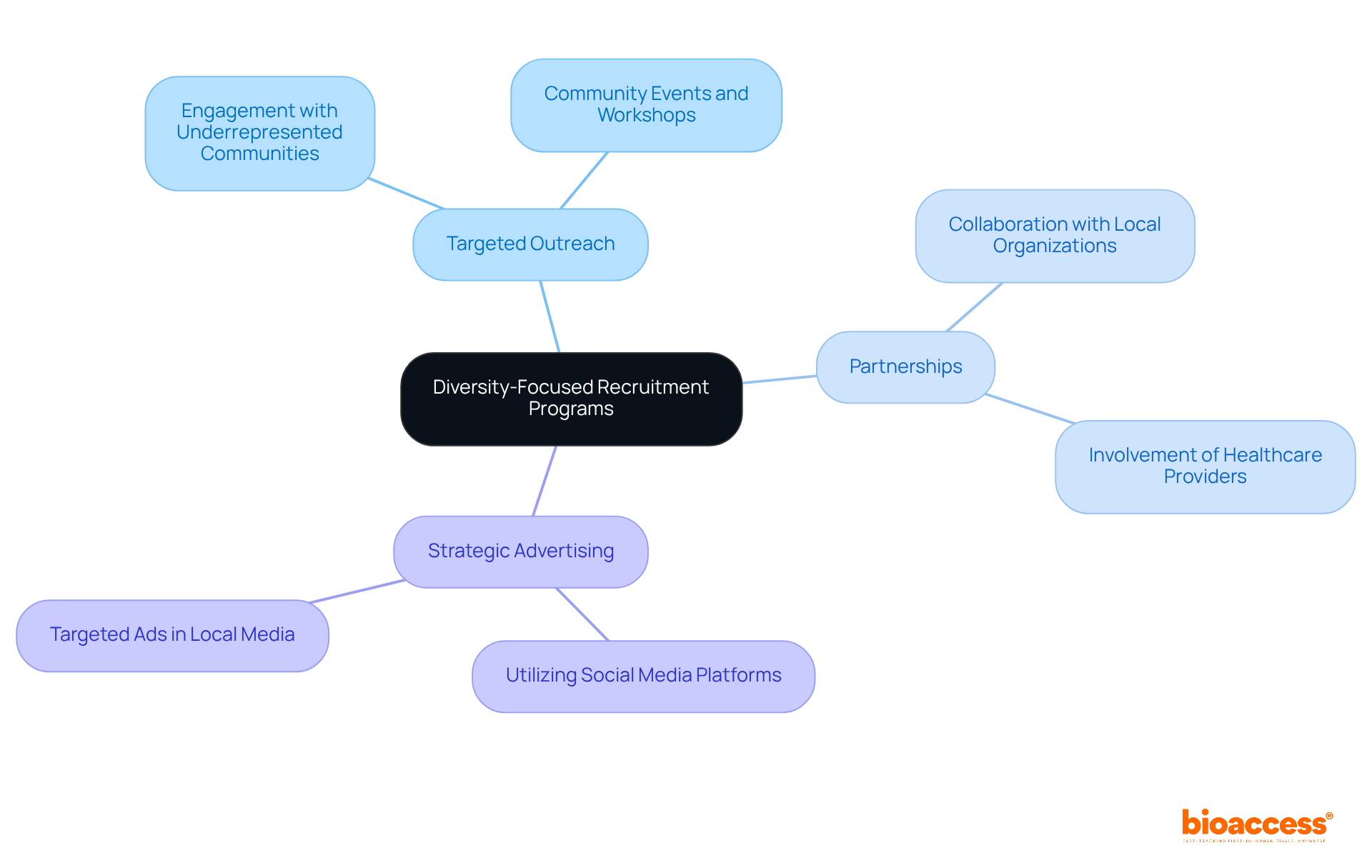
Implementing diversity training for clients is essential for fostering an inclusive environment in clinical research. This training highlights the significance of diversity, effective patient diversity recruitment strategies for engaging underrepresented populations, and best practices for creating inclusive environments. Studies indicate that diverse medical trials yield superior science and equitable healthcare outcomes, making it imperative for organizations to implement patient diversity recruitment strategies in their hiring practices.
By equipping clients with the necessary knowledge and tools, organizations can significantly enhance their hiring effectiveness. Recent trends reveal that community-centered approaches can boost minority participation by over 40% compared to traditional methods, underscoring the value of tailored training programs. Successful client training initiatives demonstrate that when research teams are trained in cultural competency and inclusive practices, they are better positioned to implement patient diversity recruitment strategies and effectively engage diverse communities.
As regulatory bodies, including the FDA, increasingly expect evidence of a genuine commitment to diversity, investing in comprehensive diversity training is not just beneficial - it’s essential for the success of clinical research. Organizations must take action now to ensure they are prepared to meet these expectations and foster an environment where all voices are heard.
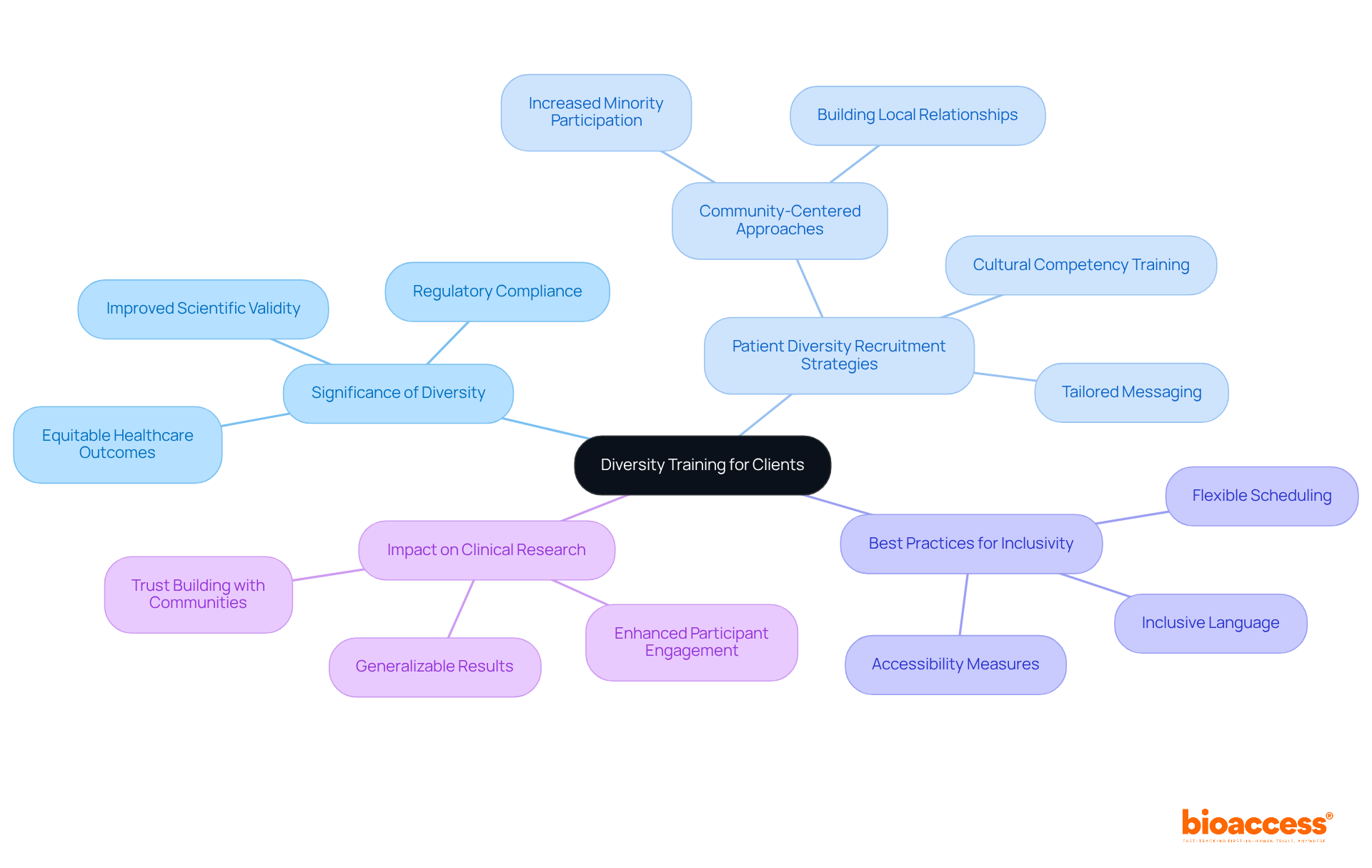
To ensure fairness in hiring, it is vital to eliminate discriminatory practices. This includes:
For instance, ineligibility rates for Black patients in research studies were discovered to be 24% compared to 17% for White patients, emphasizing the necessity for fair practices.
By promoting a setting where all applicants have equal chances, organizations can improve diversity and maintain ethical standards in research. Recent advancements in equitable hiring methods, particularly patient diversity recruitment strategies and community engagement programs, have significantly boosted participation rates among minority populations. Notably, rural patient involvement increased from 19% to 40% after navigation support.
Effective approaches involve:
As Mesa R. observed, given that doctors are the most reliable source of study information for many racial and ethnic minority patients, prioritizing fairness in participant selection is vital.
By addressing structural barriers and implementing patient diversity recruitment strategies, organizations can ensure that research accurately reflects the diverse populations impacted by the diseases being examined.

Measuring and monitoring diversity metrics is crucial for evaluating the effectiveness of recruitment strategies in clinical research. Organizations must establish key performance indicators (KPIs) that accurately reflect the demographic composition of applicants and participants. Metrics such as the Diversity Index, Equity Ratio, and Inclusion Score are essential in this regard. Notably, since 2017, mentions of 'diversity in clinical trials' in pharmaceutical filings have surged by 300%, underscoring a growing commitment to enhancing minority representation.
To gain meaningful insights, entities should continuously track DEI metrics and report them quarterly or biannually. This consistent examination of data allows organizations to identify trends, gaps, and areas for improvement, ensuring that diversity remains a central focus in hiring efforts. Furthermore, the FDA's 2024 requirement for sponsors to submit a Diversity Action Plan (DAP) for certain clinical studies highlights the necessity of structured diversity initiatives.
As Malcolm Forbes wisely stated, "Diversity: the art of thinking independently together," which emphasizes the value of varied perspectives in achieving hiring success. To foster inclusivity and trust in the research process, organizations should actively implement these strategies and metrics in their recruitment efforts.

Community outreach is essential for employing patient diversity recruitment strategies to attract a diverse range of candidates to research trials. By engaging in activities such as:
organizations can significantly raise awareness about the importance of clinical research. Successful initiatives have demonstrated that implementing patient diversity recruitment strategies by hiring individuals from varied backgrounds can lead to substantial increases in participation; one study noted a rise from 6.4% to 16.1% in commercial interventional studies through targeted outreach efforts.
Building relationships within communities fosters trust and encourages participation from underrepresented groups. This trust is crucial, as over one-third of survey respondents expressed concerns about medical experiments being conducted without their knowledge. Such findings underscore the necessity for transparency and respect in research practices. Effective patient diversity recruitment strategies, including community health fairs and educational sessions, not only boost participation rates but also ensure that research findings are relevant and beneficial to the populations involved.
Ultimately, community engagement is a cornerstone for inclusive research, promoting health equity and improving outcomes for all. Organizations must recognize the value of collaboration and take actionable steps to enhance their outreach efforts.

Enhancing patient diversity recruitment strategies is crucial for achieving sustained success in clinical studies. Organizations must regularly evaluate their strategies and actively seek feedback from participants. Staying updated on the latest advancements in patient diversity recruitment strategies is essential. By fostering a culture of learning and flexibility, organizations can significantly enhance their patient diversity recruitment strategies, ultimately leading to better outcomes.
This iterative approach not only promotes inclusivity but also enriches the quality of clinical research. It ensures that trials accurately reflect the diverse populations they aim to serve by implementing patient diversity recruitment strategies.
Consider how your organization can implement patient diversity recruitment strategies to improve its recruitment efforts. What challenges do you face in attracting varied candidates? Embracing these practices can transform your clinical studies and drive impactful results.
The significance of patient diversity recruitment strategies in clinical trials is paramount. By prioritizing inclusivity, organizations can ensure their studies accurately reflect the populations they aim to serve, ultimately leading to more reliable and applicable research outcomes. This commitment to diversity transcends mere regulatory compliance; it is a fundamental aspect of ethical and effective clinical research.
Throughout this article, we have highlighted various strategies to enhance patient diversity recruitment. These strategies include:
Each of these approaches contributes to building a more equitable research environment, fostering trust, and improving participation rates among underrepresented groups.
As the landscape of clinical research evolves, the call to action is unmistakable. Organizations must actively engage in these practices not only to comply with emerging regulations but also to lead the way in creating a more inclusive healthcare system. By embracing patient diversity recruitment strategies, stakeholders can drive meaningful change, ensuring that clinical trials reflect the diverse demographics of the communities they serve. This commitment to diversity is essential for advancing healthcare equity and achieving better outcomes for all.
What is bioaccess® and how does it contribute to patient diversity recruitment in clinical trials?
bioaccess® accelerates patient diversity recruitment by leveraging its operational bases in regions like Latin America, the Balkans, and Australia. It navigates local regulatory frameworks and engages diverse patient groups to enhance the representation of various demographics in research studies, leading to quicker and more inclusive outcomes.
Why is patient diversity important in clinical trials?
Patient diversity is crucial because it ensures that research studies reflect the populations they aim to serve, leading to more reliable and applicable outcomes. Historically, minorities have been underrepresented in research, which can affect the validity of trial results.
What strategies does bioaccess® use to recruit diverse patients?
bioaccess® employs strategies such as community outreach and culturally appropriate engagement to recruit diverse patient groups effectively. This approach helps in ensuring studies are representative of the populations they intend to benefit.
How quickly can bioaccess® activate research sites for patient recruitment?
bioaccess® has demonstrated efficiency by activating over 50 sites in under eight weeks, showcasing its capability in patient recruitment and site activation services.
What role do professional organizations play in enhancing patient diversity recruitment?
Partnering with professional organizations focused on patient diversity recruitment helps trial sponsors reach underrepresented groups through established networks and community trust. This collaboration improves recruitment efforts and ensures a more diverse participant pool.
What impact has cultural safety training had on patient enrollment?
Sites that received cultural safety training from COUCH Health reported a 26% increase in the enrollment of diverse patients, highlighting the effectiveness of such training in fostering inclusivity in clinical trials.
What is the significance of addressing unconscious bias in hiring management?
Training hiring management to identify and mitigate unconscious bias is essential for creating an inclusive hiring atmosphere. It promotes fairness in candidate evaluation and improves diversity in clinical trial selection.
How can organizations improve their hiring processes to enhance patient diversity recruitment?
Organizations can improve their hiring processes by conducting workshops on unconscious bias, implementing standardized interview processes, and forming diverse hiring panels. This proactive approach helps attract a diverse range of talent and fosters an inclusive environment.
What are the current participation rates of diverse populations in clinical trials in the U.S.?
Alarmingly, only 3%-5% of adult cancer patients and less than 4% of adults overall in the U.S. participate in clinical trials, underscoring the urgent need to improve diversity in enrollment efforts.